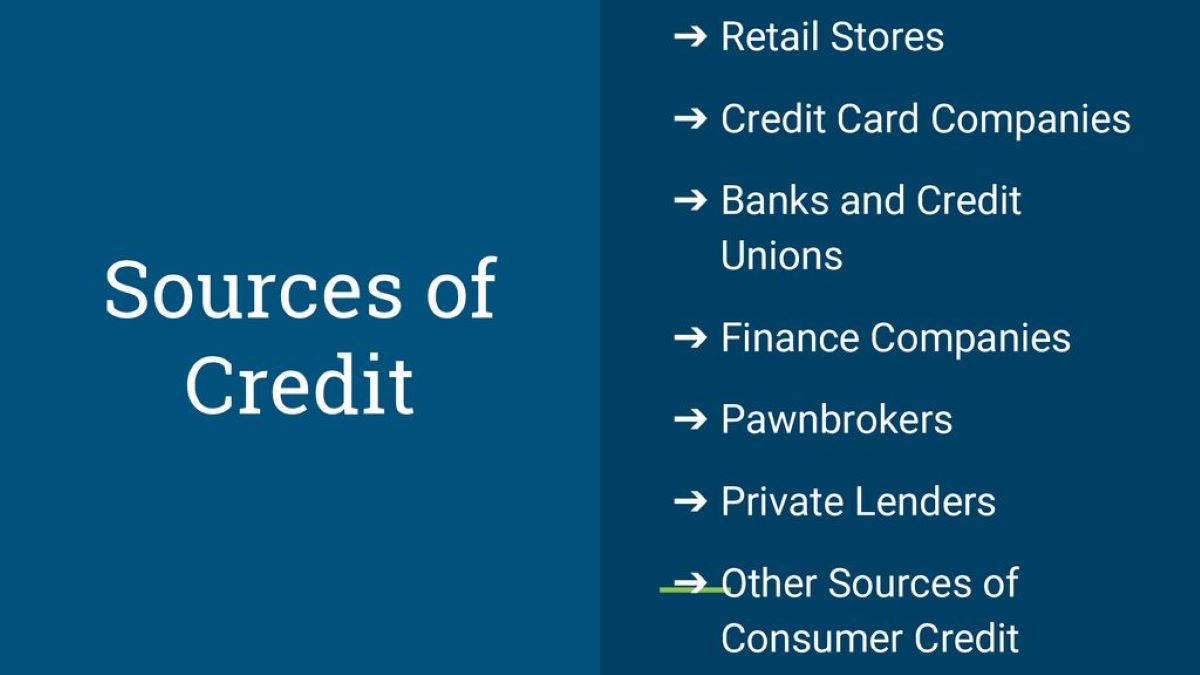

Finance
What Institutions Are Sources Of Credit?
Published: January 9, 2024
Discover the different institutions that can provide you with credit in the world of finance. Explore the various sources available to borrow funds and manage your financial needs.
(Many of the links in this article redirect to a specific reviewed product. Your purchase of these products through affiliate links helps to generate commission for LiveWell, at no extra cost. Learn more)
Table of Contents
Introduction
When it comes to obtaining credit, it’s important to understand the different sources available to individuals and businesses. Access to credit is crucial for various purposes such as starting a new business, purchasing a home, financing education, or managing unexpected expenses. While banks were traditionally the main source of credit, the financial landscape has evolved, offering a wide range of institutions that provide credit. Understanding these institutions can help individuals and businesses make informed decisions regarding their borrowing needs.
In this article, we will explore the various institutions that serve as sources of credit. We will examine the role of commercial banks, credit unions, microfinance institutions, peer-to-peer lending platforms, online lenders, credit card companies, government institutions, and nonprofit organizations in facilitating access to credit. Each of these institutions operates in a different manner and caters to different types of borrowers, making it essential to understand their specific offerings and requirements.
Whether you are an individual seeking a personal loan or a business owner looking for capital to expand your operations, it’s important to familiarize yourself with the different institutions offering credit. By understanding the options available, you can make a more informed decision that aligns with your specific needs and financial goals. Not all institutions will be suitable for every individual or business, as each has its own set of requirements, interest rates, and terms. By exploring these institutions further, you can determine which ones are most relevant to your borrowing needs.
As we delve into each institution, we will discuss their features, advantages, and considerations to help you navigate the credit landscape effectively. Keep in mind that while credit can provide valuable financial opportunities, it’s crucial to borrow responsibly and manage your debt carefully. Understanding the various sources of credit will not only enable you to choose the most suitable option but also empower you to make well-informed financial decisions.
Commercial Banks
Commercial banks are perhaps the most well-known and widely accessed sources of credit. These institutions are for-profit entities that offer a wide range of financial services, including loans and credit lines for individuals and businesses. Commercial banks typically have a network of branches and ATMs, making them easily accessible to the general public.
One of the primary advantages of borrowing from a commercial bank is the convenience and variety of loan options they offer. Whether you need a personal loan, a mortgage, a car loan, or a business loan, commercial banks can provide the necessary funds. They typically have flexible terms, competitive interest rates, and repayment schedules that suit different borrowing needs.
When obtaining credit from a commercial bank, the process usually involves a thorough evaluation of your creditworthiness, income, and collateral. Banks place a significant emphasis on credit history and may require collateral, such as a house or car, to secure the loan. This collateral serves as a backup for the bank in case the borrower defaults on the loan.
While commercial banks offer a wide range of credit options, it’s important to note that their lending criteria may be stringent, particularly for individuals with a less-than-perfect credit history. Banks prioritize the stability and creditworthiness of borrowers, which can limit access to credit for some individuals or businesses.
Additionally, commercial banks may require extensive documentation and have longer approval processes compared to other lending institutions. This is primarily due to their stringent regulatory requirements and risk management procedures. However, the benefit of borrowing from a commercial bank is the security and reliability they offer, backed by their long-standing presence and government oversight.
Overall, commercial banks are a popular option for individuals and businesses seeking credit due to their wide range of loan options and established reputation. However, the strict lending criteria and the need for collateral may limit access for individuals with a less-than-ideal credit history. It’s essential to compare offerings from different banks and weigh the advantages and disadvantages before choosing a commercial bank as your credit source.
Credit Unions
Credit unions are financial cooperatives that are owned and operated by their members. Unlike commercial banks, credit unions are not-for-profit institutions, which means they prioritize the interests of their members rather than maximizing profits. Credit unions are often formed by individuals or communities with shared interests, such as employees of a particular organization or residents of a specific area.
One of the main advantages of borrowing from a credit union is the potential for lower interest rates and fees compared to commercial banks. Since credit unions are member-owned, the focus is on providing affordable financial services to their members. This can translate into more favorable loan terms and lower borrowing costs.
Credit unions also tend to have a more personalized approach to lending, taking into consideration the individual circumstances of their members. They may be more willing to work with individuals who have limited credit history or less-than-perfect credit scores, as they prioritize member relationships over strict lending criteria. This can be particularly attractive for those who may have difficulty obtaining credit through traditional commercial banks.
In addition to providing loans, credit unions often offer other financial services such as savings accounts, checking accounts, and investment options. By becoming a member of a credit union, individuals can benefit from a holistic approach to managing their finances, with access to a range of products and services tailored to their needs.
However, it’s important to note that credit unions may have membership requirements, such as being an employee of a specific company or being a resident of a particular community. This means that not everyone may be eligible to join a credit union. It’s essential to research and identify credit unions that align with your eligibility criteria before considering them as a credit source.
Overall, credit unions are a viable alternative to traditional commercial banks for individuals and businesses seeking credit. They offer competitive interest rates, personalized service, and a member-focused approach to lending. If you are eligible to become a member of a credit union, it is worth exploring their loan options and comparing them to commercial banks to determine which institution best suits your borrowing needs.
Microfinance Institutions
Microfinance institutions (MFIs) are specialized financial institutions that provide credit and other financial services to individuals and small businesses who lack access to traditional banking services. These institutions focus on serving low-income individuals and underserved communities, aiming to promote financial inclusion and empower individuals to improve their economic prospects.
One of the key advantages of borrowing from microfinance institutions is their commitment to supporting entrepreneurship and small businesses. MFIs typically offer small loans, often referred to as microloans, which are tailored to the needs of borrowers with limited resources and in need of smaller amounts of capital. These loans can be used for various purposes, including starting or expanding a small business, purchasing equipment, or investing in income-generating activities.
Unlike traditional banks, microfinance institutions often rely on non-traditional forms of collateral and utilize innovative lending methodologies. They place more emphasis on the individual’s character and the viability of their business idea instead of relying solely on credit history and collateral. This approach opens up opportunities for individuals who may not meet the stringent requirements of commercial banks.
Microfinance institutions also offer additional services to complement their credit offerings. These services may include financial education and training, mentoring, and networking opportunities, enhancing the borrower’s ability to manage their finances and run a successful business.
While microfinance institutions play a vital role in promoting financial inclusion and supporting underserved communities, it’s important to acknowledge that their interest rates may be higher compared to traditional commercial banks. This is partly due to the higher operating costs associated with serving low-income individuals and businesses with limited collateral.
When considering microfinance institutions as a credit source, it’s crucial to research and select reputable organizations. Look for MFIs that have a strong track record, transparent lending practices, and a commitment to socially responsible lending. By doing so, you can ensure that you are borrowing from an institution that aligns with your values and provides fair and affordable financial services.
In summary, microfinance institutions serve as an important source of credit for individuals and small businesses who are underserved by traditional banking services. They offer flexible loan options, innovative lending methodologies, and additional support services to promote financial inclusion and socioeconomic empowerment. If you are in need of a small loan and facing challenges accessing credit from commercial banks, microfinance institutions may offer a viable alternative to meet your borrowing needs.
Peer-to-Peer Lending Platforms
Peer-to-peer (P2P) lending platforms have revolutionized the lending landscape by connecting borrowers directly with individual lenders, cutting out the traditional banks as intermediaries. These online platforms enable individuals and businesses to borrow money from other individuals or investors, often at more favorable interest rates compared to traditional lenders.
One of the primary advantages of peer-to-peer lending platforms is the potential for lower interest rates. Since borrowers are connecting directly with lenders, there is no need for the overhead costs associated with traditional financial institutions. This allows for more competitive interest rates, benefiting both borrowers and lenders.
P2P lending platforms operate by facilitating the lending process from start to finish. They provide an online marketplace where borrowers can create loan listings, outlining their borrowing needs and desired interest rates. Potential lenders can then review these listings and choose to fund the loan based on their criteria and risk appetite. Once funded, the platform manages the repayment process, distributing the repayments back to the lenders.
Additionally, P2P lending platforms provide a streamlined and accessible borrowing experience. The application process is typically straightforward, involving an online application and documentation submission. The platform performs a credit assessment and assigns an interest rate based on the borrower’s creditworthiness, helping match borrowers with potential lenders who are willing to fund their loan.
While P2P lending platforms offer exciting opportunities for borrowers and lenders alike, there are risks involved. As with any investment, there is a possibility of default or late payments from borrowers, which could result in financial loss for lenders. It’s important for lenders to carefully evaluate the risk-return profile of each loan listing and diversify their investments across multiple borrowers to mitigate risk.
Additionally, borrowers should consider that interest rates on P2P loans may be higher for individuals with less-than-perfect credit histories. The interest rate assigned to a borrower depends on their creditworthiness, as assessed by the platform. It’s crucial to compare the interest rates and terms offered by different platforms and assess the suitability based on your individual circumstances.
In summary, peer-to-peer lending platforms offer an alternative credit source that connects borrowers directly with investors. They provide an accessible, streamlined borrowing experience and the potential for more favorable interest rates compared to traditional lenders. However, it’s important to carefully assess the risk and evaluate the terms offered by each platform before entering into a loan agreement. By conducting thorough due diligence, borrowers and lenders can take advantage of the benefits offered by P2P lending platforms while minimizing potential risks.
Online Lenders
Online lenders have emerged as a popular and convenient source of credit in the digital age. These lending institutions operate exclusively online, providing borrowers with access to quick and efficient financing options. Online lenders offer a wide range of loans, including personal loans, business loans, student loans, and more.
One of the main advantages of online lenders is their speed and convenience. The entire loan application process can be completed online, allowing borrowers to apply for a loan from the comfort of their own homes. Online lenders leverage technology to streamline the application and approval process, often providing instant decisions and faster funding compared to traditional banks.
Online lenders typically have more flexible lending criteria compared to traditional financial institutions. While they still assess a borrower’s creditworthiness, they may be more willing to work with individuals who have less-than-perfect credit histories. This makes online lenders a viable option for individuals who may face challenges accessing credit through traditional channels.
Additionally, online lenders often offer competitive interest rates and transparent terms. They have lower overhead costs compared to brick-and-mortar banks, allowing them to pass on these savings to borrowers in the form of more favorable rates. However, it’s essential to compare offers from different online lenders and carefully review the terms and fees associated with the loan before making a decision.
Furthermore, online lenders provide a user-friendly borrowing experience through their intuitive and easy-to-navigate websites. Borrowers can submit loan applications, review loan offers, and manage their loan accounts online. Many online lenders also offer helpful resources and tools to assist borrowers in understanding their financial options and making informed decisions.
It’s important to note that while online lenders offer convenience and accessibility, borrowers should exercise caution and ensure they are dealing with a reputable and trustworthy lender. Research the lender’s background, read customer reviews, and check for any official certifications or accreditations to ensure they are operating legally and ethically.
In summary, online lenders provide a convenient and flexible source of credit for individuals and businesses. They offer streamlined application processes, competitive interest rates, and the potential to work with borrowers who may have difficulty accessing credit through traditional banks. However, it’s crucial to research and choose reputable online lenders to ensure a positive borrowing experience. By leveraging the benefits of technology, online lenders have transformed the borrowing landscape, providing efficient and accessible financing options for those in need.
Credit Card Companies
Credit card companies play a major role in providing individuals and businesses with access to credit. These companies issue credit cards that allow users to make purchases and borrow money up to a predetermined credit limit. Credit cards offer a convenient and widely accepted form of payment, making them a popular choice for many consumers.
One of the primary advantages of using credit cards is the flexibility they offer. Credit cardholders have the option to pay their balances in full each month or carry a balance and make minimum payments over time. This allows individuals to manage their cash flow and make purchases even if they don’t have the full amount available at the time of purchase.
Credit card companies often offer additional benefits and rewards programs to attract and retain customers. These rewards can range from cashback, travel points, or discounts at specific retailers. By using credit cards responsibly, individuals can take advantage of these perks and potentially save money on their purchases.
However, it’s important to note that credit cards can come with high-interest rates, especially if balances are not paid off in full. It’s crucial for individuals to understand the terms and conditions associated with their credit cards, including interest rates, fees, and any applicable penalties. Responsible credit card usage involves making timely payments, keeping balances low, and avoiding excessive debt.
Credit cards also provide added security and protection for consumers. Many credit card companies offer fraud protection, zero-liability policies, and purchase protection, which can be valuable in case of unauthorized transactions or faulty merchandise.
Beyond individual credit cards, credit card companies also offer business credit cards specifically tailored to the needs of businesses. These cards can provide access to capital for businesses, along with expense tracking features and rewards programs designed to benefit small business owners.
It’s worth noting that credit card companies typically have their own set of underwriting criteria and eligibility requirements. They assess individuals’ creditworthiness and income before approving credit card applications. Therefore, individuals with lower credit scores or limited credit history may find it more challenging to qualify for certain credit cards.
In summary, credit card companies are a significant source of credit for individuals and businesses. They offer flexibility, convenience, and rewards programs, making them a popular financing option. However, responsible credit card usage is essential to avoid high-interest debt and manage finances effectively. Understanding the terms and conditions of credit cards and using them responsibly can help individuals and businesses leverage the benefits of credit cards while avoiding potential pitfalls.
Government Institutions
Government institutions play a crucial role in providing credit and financial assistance to individuals and businesses. These institutions offer various programs and initiatives aimed at promoting economic growth, supporting specific industries, and assisting individuals with specific needs.
One of the primary ways governments provide credit is through their development finance institutions (DFIs). DFIs are government-owned financial institutions that provide long-term loans and funding for projects in sectors such as infrastructure, agriculture, and small business development. These loans often have favorable terms and lower interest rates compared to commercial lenders, as their main objective is to facilitate economic development rather than profit generation.
In addition to DFIs, governments may also offer loan programs targeted at specific demographics or sectors. For example, governments may provide student loans to support education and workforce development, or loans for first-time homebuyers to promote homeownership. These loans often have favorable terms, such as lower interest rates or flexible repayment options, to make them more accessible and affordable.
Government institutions also provide credit guarantees to encourage lending by commercial banks and other financial institutions. These guarantees reduce the risk for lenders, making them more willing to provide loans to individuals and businesses who may not meet the strict lending criteria. By assuming a portion of the risk, the government encourages access to credit for underserved populations or sectors that may otherwise struggle to obtain financing.
Furthermore, governments may establish grant programs or subsidies to support businesses and individuals in need of financial assistance. These programs provide non-repayable funds, helping to stimulate innovation, job creation, and economic growth.
It’s important to note that accessing credit from government institutions may require meeting specific eligibility criteria and going through an application process. Each program or initiative may have its own set of requirements and application procedures, which individuals or businesses must navigate to secure the funding they need.
In summary, government institutions provide credit and financial assistance to individuals and businesses through programs, loan initiatives, loan guarantees, grants, and subsidies. These initiatives aim to promote economic growth, support specific industries, and provide access to credit for underserved populations. Understanding the programs available and their specific requirements can help individuals and businesses tap into these government resources and secure the necessary funding to achieve their goals.
Nonprofit Organizations
Nonprofit organizations play a crucial role in providing credit and financial assistance to individuals and communities in need. These organizations are mission-driven and dedicated to serving the public and addressing specific social or economic challenges. While their primary focus may not be on lending, many nonprofit organizations offer credit programs and services to support individuals and businesses.
Nonprofit organizations often provide microcredit or small loans to individuals and entrepreneurs who may not have access to traditional banking services. These loans are typically targeted towards underserved populations, such as low-income individuals, women, or minority entrepreneurs. The goal is to provide these individuals with the necessary capital to start or expand their businesses and improve their financial stability.
In addition to small loans, nonprofit organizations may offer financial education and training programs to help borrowers build financial literacy and develop effective money management skills. These programs aim to empower individuals and promote long-term financial well-being.
Nonprofit organizations may also collaborate with traditional financial institutions, such as banks or credit unions, to provide loan guarantees or loan loss reserve funds. These initiatives help reduce the risk for lenders and encourage them to provide loans to individuals or businesses that may not meet their traditional lending criteria.
Furthermore, nonprofit organizations may offer grant programs or funding opportunities to support individuals or initiatives aligned with their mission. Unlike loans, grants do not need to be repaid, making them a valuable source of funds for individuals or organizations focused on social or community-based projects.
It’s important to note that nonprofit organizations have their own specific eligibility criteria and application processes for their credit programs and funding opportunities. They often prioritize individuals or projects that align with their mission and demonstrate a commitment to positive social impact.
In summary, nonprofit organizations provide credit and financial assistance to individuals and communities through various programs and initiatives. These organizations focus on empowering underserved populations, promoting financial literacy, and supporting initiatives that align with their mission. Understanding the offerings and requirements of nonprofit organizations can help individuals and businesses access the credit they need to achieve their goals while making a positive impact in their communities.
Conclusion
When it comes to accessing credit, there are numerous institutions available to meet the diverse needs of individuals and businesses. Commercial banks, credit unions, microfinance institutions, peer-to-peer lending platforms, online lenders, credit card companies, government institutions, and nonprofit organizations all serve as valuable sources of credit.
Commercial banks offer a wide range of loan options but may have stricter lending criteria. Credit unions prioritize member relationships and often offer more favorable terms for borrowers. Microfinance institutions cater to individuals and small businesses with limited access to traditional banking services.
Peer-to-peer lending platforms connect borrowers directly with individual lenders, offering potential for lower interest rates and faster funding. Online lenders provide convenience, speed, and flexibility in the borrowing process, often with competitive interest rates.
Credit card companies offer flexible borrowing options, rewards programs, and convenient payment methods, but it’s important to manage credit card debt responsibly. Government institutions provide loans, grants, and guarantees to support economic growth and specific sectors.
Nonprofit organizations offer credit programs, grants, and financial education resources to empower individuals and address social or economic challenges in underserved communities.
It’s crucial to understand the features, advantages, and considerations of each institution, as well as their specific eligibility criteria and requirements. By doing so, individuals and businesses can make informed decisions and choose the most suitable credit source for their needs.
Regardless of the credit source chosen, responsible borrowing and managing debt should always be prioritized. Borrowers should conduct thorough research, compare options, and carefully review the terms and conditions of any credit agreement. This will ensure that credit is utilized effectively and that financial obligations are met in a timely manner.
By understanding the array of institutions serving as sources of credit, individuals and businesses can access the financing they need to achieve their goals, whether it’s starting a business, funding a purchase, or managing unexpected expenses. Take the time to explore the offerings of each institution to find the credit source that aligns best with your unique financial circumstances and goals.














